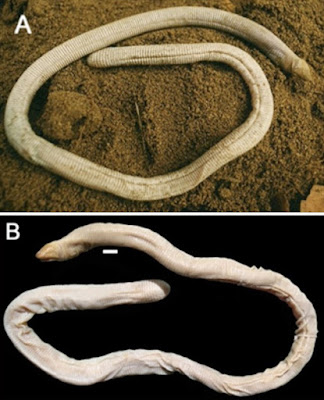 |
| Leposternon octostegum (Duméril, 1851)
in Barros-Filho, Freitas, Silva, et al., 2019.
|
ABSTRACT
The amphisbaenian Leposternon octostegum (Duméril, 1851) is redescribed based on newly collected material from the state of Bahia, Brazil. Species validity was confirmed, and comparisons made to other Leposternon species and to the scarce literature available on Leposternon octostegum taxonomy. Aspects of meristic annuli methodology are reviewed, and nomenclatural adjustments for some scales are proposed. To place this information in its taxonomic context, a species identification key for the Brazilian species of the genus Leposternon is provided. The present redescription contributes to a better understanding of Amphisbaenia taxonomy, thus also enabling the design of more adequate conservation and management strategies for the species belonging to this group.
Keywords: Amphisbaenia, Bahia, Brazil, Leposternon octostegum, meristic methodology, pholidosis nomenclature, taxonomy
Leposternon octostegum (Duméril)
Amphisbaena octostega (Duméril)
Lepidosternon octostegum Duméril, 1851, p. 150–151.
Terra typica: “Brésil”. Holotype: MNHN 7055.
Diagnosis: A species of Leposternon with an enlarged, polygonal azygous shield atop the head, which, however, does not exclude the discrete prefrontals, oculars and first temporals shields of the dorsal cephalic area posterior to the rostronasal; one large supralabial and one large infralabial shield on each side of mouth; a large mental shield (postmental shield absent, probably fused with the mental shield); 353–382 ventral, postpectoral half-annuli.
Definition: A slender, medium-sized (388mm maximum adult total length) form of Leposternon, with an enlarged, polygonal azygous shield atop the head; in dorsal view, the rostronasal, the prefrontals, the oculars, the first temporals and a small pair of occipitals are also clearly discernible; one large supralabial and one large infralabial; mental and postmental shields, probably fused; three pairs of enlarged shields along the midline, with left and right asymmetries: the anterior pair forms a rough stretched pentagon pointing backwards, the second pair has irregular polygons tending to a medial suture in an “X” disposition and the posterior pair showing polygonal transversely elongated shields, larger caudad than rostrad; 353–382 ventral, 357–397 dorsal postpectoral half-annuli; 24–33 dorsal half-annuli scales; 23–29 ventral half-annuli scales; 12–15 caudal annuli; a short, cylindrical and round ending tail; 121–142 precloacal vertebrae; absent precloacal pores and autotomy. Living specimens have a pale grizzled background coloration, with none or inconspicuous sparse, diminute and irregularly distributed dorsal brownish pigments, more concentrated in the second half of the body (Image 23A). Alcohol preserved specimens display a more pale brown (beige) brownish or whitish background coloration, and the pigments are more subtle. The sample from Municipality of Camaçari exhibited a different coloration, with marked brownish blotches or dorsal pigment dots evident along most of the body and in the tail.
José Duarte de Barros-Filho, Marco Antonio de Freitas, Thais Figueiredo Santos Silva, Mariana Fiuza de Castro Loguercio and Maria Celeste Costa Valverde. 2019. Redescription of Leposternon octostegum (Duméril, 1851), with An Identification Key for Brazilian Leposternon species, Remarks on Meristic Methodology, and A Proposal for Pholidosis Nomenclature (Squamata: Amphisbaenidae). Journal of Threatened Taxa. 11(1); 13058-13086. DOI: 10.11609/jott.3597.11.1.13058-13086

